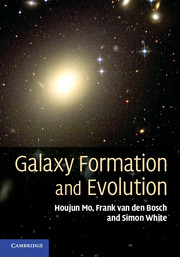Book contents
- Frontmatter
- Contents
- Preface
- 1 Introduction
- 2 Observational Facts
- 3 Cosmological Background
- 4 Cosmological Perturbations
- 5 Gravitational Collapse and Collisionless Dynamics
- 6 Probing the Cosmic Density Field
- 7 Formation and Structure of Dark Matter Halos
- 8 Formation and Evolution of Gaseous Halos
- 9 Star Formation in Galaxies
- 10 Stellar Populations and Chemical Evolution
- 11 Disk Galaxies
- 12 Galaxy Interactions and Transformations
- 13 Elliptical Galaxies
- 14 Active Galaxies
- 15 Statistical Properties of the Galaxy Population
- 16 The Intergalactic Medium
- A Basics of General Relativity
- B Gas and Radiative Processes
- C Numerical Simulations
- D Frequently Used Abbreviations
- E Useful Numbers
- References
- Index
9 - Star Formation in Galaxies
Published online by Cambridge University Press: 05 June 2012
- Frontmatter
- Contents
- Preface
- 1 Introduction
- 2 Observational Facts
- 3 Cosmological Background
- 4 Cosmological Perturbations
- 5 Gravitational Collapse and Collisionless Dynamics
- 6 Probing the Cosmic Density Field
- 7 Formation and Structure of Dark Matter Halos
- 8 Formation and Evolution of Gaseous Halos
- 9 Star Formation in Galaxies
- 10 Stellar Populations and Chemical Evolution
- 11 Disk Galaxies
- 12 Galaxy Interactions and Transformations
- 13 Elliptical Galaxies
- 14 Active Galaxies
- 15 Statistical Properties of the Galaxy Population
- 16 The Intergalactic Medium
- A Basics of General Relativity
- B Gas and Radiative Processes
- C Numerical Simulations
- D Frequently Used Abbreviations
- E Useful Numbers
- References
- Index
Summary
By and large, a galaxy is observed through, and defined by, its stellar content. Hence, any theory of galaxy formation has to address the question of how stars form. As we have seen in the previous chapter, the baryonic gas in galaxy-sized halos can cool within a time that is shorter than the age of the halo. Consequently the gas is expected to lose pressure support and to flow towards the center of the halo potential well, causing its density to increase. Once its density exceeds that of the dark matter in the central part of the halo, the cooling gas becomes self gravitating and collapses under its own gravity. As we have seen in the previous chapter, in the presence of efficient cooling, self-gravitating gas is unstable and can collapse catastrophically. Ultimately, this cooling process may lead to the formation of dense, cold gas clouds within which star formation can occur. In this chapter we take a closer look at the actual process of star formation. The main questions to be addressed are:
(i) When does large-scale star formation occur in a galaxy?
(ii) What are the main processes that drive star formation?
(iii) What is the rate at which stars form in a gas cloud?
(iv) What mass fraction of a gas cloud can be converted into stars?
(v) What is the initial mass function (IMF), which describes the mass distribution of stars at birth?
- Type
- Chapter
- Information
- Galaxy Formation and Evolution , pp. 417 - 448Publisher: Cambridge University PressPrint publication year: 2010



